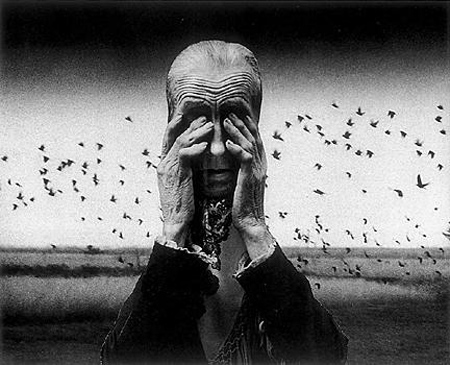Gresham’s Law: the bad tends to drive out the good…
…The Holocaust and Auschwitz. The question continues to haunt us, and the answers still elude us. We will never be able to justify the Holocaust, to rationalize it, to explain why it occurred. It is simply impossible for some to undergo a “Eureka” moment and to reveal a explanation linked to the Divine that would answer all. The holocaust is beyond our comprehension, and we cannot explain matters that are beyond our understanding, limited as it is. We who were not in concentration camps cannot possibly conceive what it was like, and those who were interned in Dachau or Buchenwald before WWII cannot picture Treblinka.

—The collages created by Alex Ayaan, a photographer and graphic artist from Bucharest, exemplify how history and collective memory collapse into each other in Holocaust visual culture. Ayaan employs the same juxtaposition (past/present) and the same visual pattern (black and white/color) inaugurated by Alain Resnais’ Nuit et Brouillard (Night and Fog, 1955), that became a recurring topos in Holocaust films up to Schindler’s List. The death camp is here both a memorial site and a contemporary “touristic” structure.—Read More:http://holocaustvisualarchive.wordpress.com/category/contemporary-art/
There was a time when man had rather romantic dreams of human perfectibility, of a generally upward trend in history, of man evolving above savagery and barbarism. It was thought that all the achievement in science and education would raise the individual above the beast: cannibals, mountains of skulls, public burnings for heresy etc. were the stuff of primitives inconceivable in this new world of progress. The carnage of World War I dulled the sheen somewhat, but certain basic concepts of man and culture persisted. Somehow, there was a belief that man would live by principle, and would continue to be “moral,” and that the logic of moral relativism would never be pursued to its logical conclusion.
There is a line of thought that says if God had intervened to keep Auschwitz from happening, man would have assumed that it was the human mind, the human spirit or human civilization which prevented the Holocaust, and that man has no need for god. That is, if man is to be truly free, then he must be free to make his own moral decisions, accepting or rejecting a given absolute moral standard, or else he is neither free nor even human. The error here of course is confusing the ability to choose between good and evil with a capacity to define what is right and wrong. Auschwitz was a horror only by a certain definition. Moral relativism is a slippery slope; man seems innately programmed to attribute seemingly miraculous events or good fortune to his own virtue, or to nature, since reason and intellect have advanced so far and become so infallible or so the argument goes…

Samuel Bak: Some might call it elaboration of Trauma; I hope that my art is more than that.
To conclude, it is not “Bak” who chose the Holocaust — it is rather the Holocaust that was put on “Bak’s” shoulders a very distinct,almost inescapable need to give testimony.
I feel that we live in a world polluted by triviality. The Holocaust is a portentous subject. Artists who have chosen to deal with matters of importance, who are questioning the existential dimensions of life, death, good and evil, turn to the experience of the Shoah and believe that their images will stir emotions and stimulate reflection. Visual statements can be stronger than words. But the rhetoric of painting has its limitations. Visual Arts are mostly physical, they require places and spaces, and they can bear only so much moral weight. Besides, certain experiences demand verbal expression. …Read More:http://chgs.umn.edu/museum/responses/bak/






 COMMENTS
COMMENTS